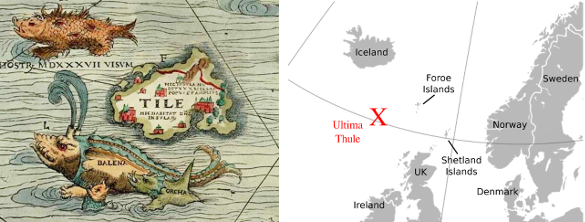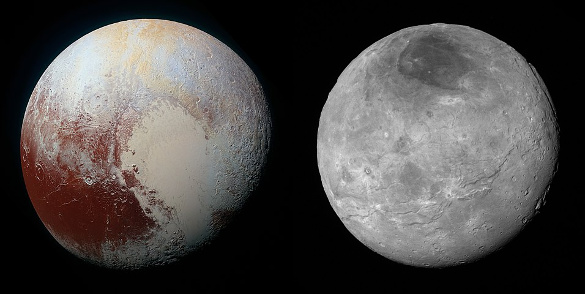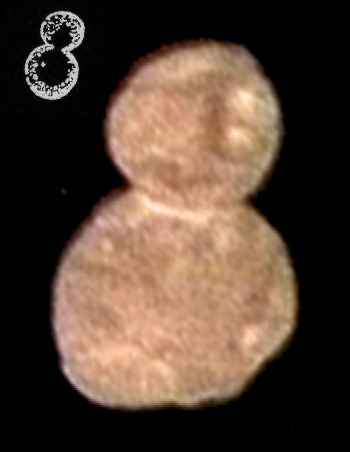Ultima Thule
January 7, 2019
Man is always pushing back his
territorial frontiers, so the location of the most distant place has changed throughout
history. The
Roman Empire had extended to
Britain by the
1st century, after
Julius Caesar invaded during the
Gallic Wars, but Rome's reach did not extend
farther north. The farthest region on Earth in those days was known as
Ultima Thule, from the
Greek word, θουλη (Thoule), for the most
northerly place.

Ultima Thule (left) depicted as an island on the 1539 Carta Marina of Olaus Magnus (1490–1557). Also shown is its approximate location on a modern map. Alternatively, Ultima Thule has been placed as Norway, Iceland, Greenland, or the Shetland Islands. (Left image, and right image, a modified version of a map created by Ssolbergj, both from Wikimedia Commons.)
Ultima Thule has a long and interesting history.
Greek historian,
Polybius, wrote in his circa 140 BC
Histories that
Pytheas of Massalia claimed that Thule was in a region of
amorphous material combining
earth,
air, and
water.[1] Several
centuries later,
Strabo (c. 63 BC - c. AD 24) wrote in his
Geographica that Thule was six days' sailing voyage north of Britain, and it was near the
frozen sea.
Avienus (c. 350 AD) wrote in his
Ora Maritima that
summer nights on Thule lasted only two
hours, a clear reference to the
diurnal cycle at high
latitudes.
Pliny the Elder in his 77 AD
Natural History cited the claim by Pytheas that the
Sun did not
set at Thule in summer and did not
rise in
winter. Strabo, also citing Pytheas, wrote further that Thule was inhabited, and its people subsisted on
millet,
herbs,
roots,
fruits, and crudely processed
grain. In later times, Ultima Thule was alternatively conceived to be
Norway,
Iceland,
Greenland, or the
Shetland Islands.

Land of the Midnight Sun - Excerpt from Pliny's Naturalis_Historia (Natural History) , Book 2, Chapter 78, describing the period of daylight on Thule (Thyle). "...during the solstitial period, as the sun approaches to the pole of the world, and his orbit is contracted, the parts of the earth that lie below him have a day of six months long, and a night of equal length when he is removed to the south pole. Pytheas of Marseilles informs us, that this is the case in the island of Thule..." (Original Latin and English translation via Tuft's University Project Perseus.[2-3])
Mankind has just extended its reach to a new, distant point, a
minor planet with the not too memorable designation,
(486958) 2014 MU69. The name of this
trans-Neptunian object in the
Kuiper belt incorporates the year of its discovery, 2014, by the
Hubble Space Telescope. It now carries the Ultima Thule name.
This minor planet has an
apparent magnitude of about 27, so it's too faint to be observed by a
terrestrial telescope and could only be imaged by Hubble. Ultima Thule was discovered in a deliberate search for a suitable trans-Neptunian object to be visited by the
New Horizons spacecraft after its
successful encounter with
Pluto and its
satellites on on July 14, 2015.

Pluto and one of its satellites, Charon, as imaged by the New Horizons spacecraft on July 14, 2015. Left image, an enhanced color view of Pluto combining blue, red and infrared images. Right image, Pluto's largest moon Charon. Both images from NASA/Johns Hopkins University Applied Physics Laboratory/Southwest Research Institute, via Wikimedia Commons.
New Horizons
encountered Ultima Thule in the early hours of January 1, 2019, with closest approach at 05:33
UTC. At this encounter, New Horizons was 43.4
astronomical units (AU) from the Sun, so
radio telemetry had a transit time of about six hours. While an early image was acquired (see below), the full data download will take 20 months, since the data rate is 1-2
kilobits per second. It's amazing that
signals can be received on Earth from New Horizon's 12
watt X-band transmitter.

First color image of Ultima Thule, (486958) 2014 MU69.
The colors on this image were produced by combining near infrared, red and blue images taken at a distance of 85,000 miles on January 1, 2019.
While many have characterized the shape as a snowman, it reminded me of budding yeast, as shown in the inset image at the upper left hand corner.
(Ultima Thule image from NASA/Johns Hopkins University Applied Physics Laboratory/ Southwest Research Institute, and budding yeast image from The New Student's Reference Work, 1914 edition, vol. 5, p. 137, both via Wikimedia Commons)
References:
- Polybius, "The Histories," Book XXXIV, from vol. VI of the Loeb Classical Library edition, 1922 thru 1927, from Bill Thayer's Web Site at the University of Chicago.
- Pliny the Elder, "Naturalis Historia (in Latin)", Karl Friedrich Theodor Mayhoff, Ed. (Teubner, 1906), via Tuft's University Project Perseus.
- John Bostock and H.T. Riley, "The Natural History. Pliny the Elder," Taylor and Francis (London, 1855), Book 2, chapter 77, "Where the Days are the Longest and Where the Shortest," via Tuft's University Project Perseus.
- NASA New Horizons Website.
Linked Keywords: Territory; territorial; frontier; history; Roman Empire; Roman Britain; 1st century; Julius Caesar; Gallic Wars; Scandinavia; Ultima Thule; Greek language; Greek word; arctic; northerly; island; Carta Marina; Olaus Magnus (1490–1557); map; Norway; Iceland; Greenland; Shetland Islands; Ssolbergj; Wikimedia Commons; Ancient Greece; Greek; historian; Polybius; The Histories (Polybius); Pytheas of Massalia; amorphous material; earth (classical element); air (classical element); water (classical element); century; Strabo (c. 63 BC - c. AD 24); Geographica; sea ice; frozen sea; Avienus (c. 350 AD); Ora Maritima; summer; night; hour; diurnal cycle; latitude; Pliny the Elder; Natural History (Pliny); Sun; sunset; sunrise; winter; millet; herb; root; fruit; food grain; Land of the Midnight Sun; Naturalis Historia (Natural History); daylight; solstice; solstitial; North Pole; geocentric orbit; earth; month; night; south pole; Pytheas of Marseilles; Latin; English translation; human; mankind; minor planet; (486958) 2014 MU69; trans-Neptunian object; Kuiper belt; Hubble Space Telescope; apparent magnitude; terrestrial; telescope; New Horizons spacecraft; Pluto system encounter; Pluto; natural satellite; Charon (moon); NASA; Johns Hopkins University Applied Physics Laboratory; Southwest Research Institute; Coordinated Universal Time; UTC; astronomical unit (AU); radio telemetry; bit rate; kilobits per second; signal; watt; X-band; transmitter; near infrared; snowman; budding; yeast.